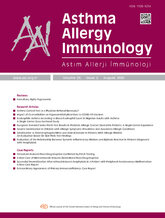


Background: Allergic contact dermatitis (ACD) is a Type IV hypersensitivity reaction that can be challenging to diagnose in children due to its resemblance to other dermatologic conditions such as atopic dermatitis. Despite historical beliefs, recent studies show that ACD is prevalent in pediatric populations, with an increasing number of cases reported.
Objective: This study aimed to investigate the prevalence of allergic sensitization in children with suspected ACD, identify the most common allergens, and examine the relationship between allergic diseases and patch test positivity.
Materials and Methods: A retrospective study was conducted at the Pediatric Allergy and Immunology Clinic between April 2023 and December 2024, including children aged 2–18 years. Patients underwent patch testing using the European standard series and were assessed for demographic data, allergic disease history, and laboratory tests.
Results: A total of 99 patients with suspected allergic contact dermatitis (ACD) were evaluated, with a median age of 14 years (IQR: 9–16). Patch test positivity was detected in 58 patients (58.6%), and clinically relevant sensitizations were identified in 32 of them (55.1%). The most commonly affected site was the hand (44%), frequently associated with metal exposure. At least one allergic disease was present in 50.5% of the patients, with atopic dermatitis (34.4%) being the most prevalent. Skin prick test positivity was observed in 28% of the patients, predominantly to pollen (22.2%). The most frequently detected contact allergens were metals (26.8%), particularly nickel sulfate (11.8%).
Conclusion: ACD is a common condition in children, with metals and preservatives as the most prevalent allergens. Early diagnosis through patch testing and proactive management of environmental exposures are crucial for improving patient outcomes and reducing the impact of ACD on the quality of life.